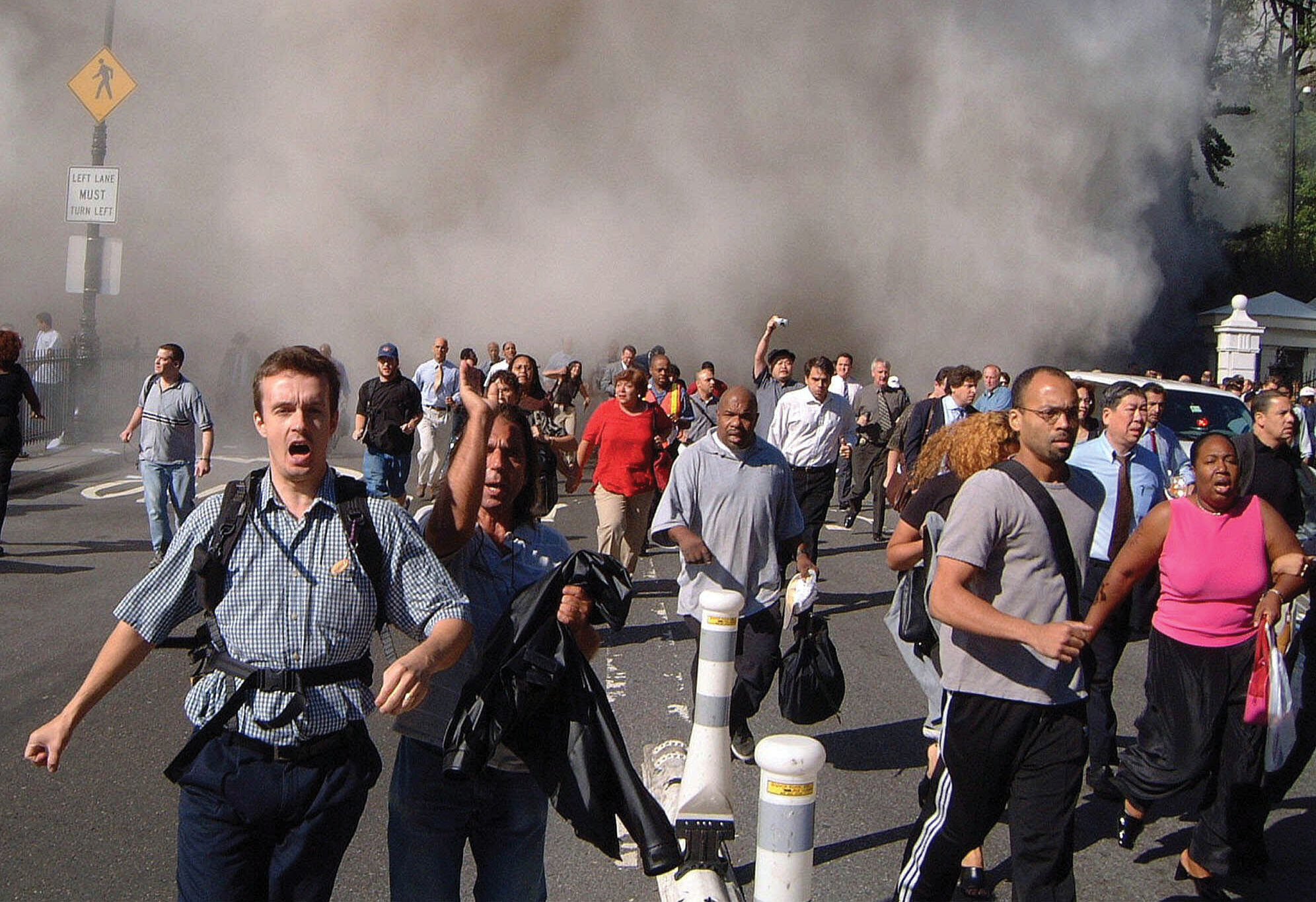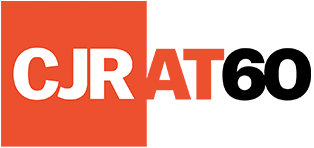I was outside P.S. 89 tailing a city council candidate on election day when I heard the plane. It made a heavy rasping sound. That was at 8:46 a.m. I watched it fly above my head and into the north side of WTC 1. I could see only smoke and a hole. I started running toward it.
It took me perhaps two minutes to get to the great square off Church Street that was then still bounded by those two massive towers. Millions of documents floated in the sky. I got under a ledge and ran out as far as I could. Fist-sized chunks of concrete and long strips of steel and tiny pieces of glass were hitting the ground beyond the ledge. Three building maintenance men and a cop came out. We told each other what we had just seen and when we saw the bodies falling we were rendered inarticulate. Jesus Christ oh Jesus Christ, someone said. At a distance falling debris can be mistaken for falling bodies but I can say this with certainty: I saw two bodies fall and I saw four lying on the ground. One fell on the opposite edge of the square, arms out and legs straight. I heard it tear through the roof of a bandstand and I heard it hit the ground. Closer to me another woman struck the ground. Both times I heard a sound that, had I not seen the impact, I would have taken for an explosion.
I knew the body in front of me was a woman because she was wearing a skirt (sea-green) and I could see her legs. She had blond hair but I could not see her face. I would not say that I wanted to see it but I thought it was important. I thought if I could edge around the corner I could get closer to her and still be protected by the ledge, but when I made the turn I became terrified and backed up.
At 9 a.m. the other plane crashed into WTC 2. When the glass fell, I pressed myself against the wall and covered my face with my left arm. I heard the glass tinkling around me and soothing music coming from speakers embedded in the ledge above me.
I went back to the street and around the corner to get into the complex from the south side. I ran through the deserted farmer’s market and got under the ledge on Liberty Street. Debris was still falling. Something bounced off a stoplight. It was getting hard to breathe. A policeman across the street started yelling at me. At 9:25, I saw fifteen to twenty-five firemen cross the Liberty Street walkway to WTC 2.
Two policemen came to get me. We all walked back east, then they went inside WTC 2 and told me to leave. I showed them my press pass. They told me to leave again. I waded through ash, rubble, and paper to the east side of Church, to what looked like a medical staging area. I ducked under the tape and was accosted immediately. I showed the pass. This time it worked.
I spoke with a man named Reyher Kelly who had been on the seventy-eighth floor, the sky lobby of WTC 2, when the plane hit. “We saw people fall out. I was getting into the elevator when it hit us,” he said. “The explosion just knocked us down.” Bill Hay was in WTC 1 on the fifty-fifth floor giving a lecture at the World Trade Institute when the first plane hit. “The building started to rock,” he said. “I looked out the window, saw all the debris falling and just left my laptop, my billfold, passport, plane tickets. They’re all gone.” Allan Mean was in the WTC 2 elevator at impact. The elevator dropped. “My leg is tingling,” he told an EMT.
Then I ran into the same policeman who’d been yelling at me before, and I was escorted out. The area was flooded with police trying to funnel all the civilians uptown. I figured I’d turn onto Vesey and go a few blocks east before heading downtown and then doubling back. I didn’t make it very far. There was a roar that sounded like being next to a jet engine, which I first took for another crashing plane. I was wrong: WTC 2 was collapsing, around 10 a.m. People started to stampede. I joined them. The cloud rolled out toward us; we were actually racing it up Park Row, heavy, suffocating dust, grains of something hard. It caught me finally. I tried to hold my breath and find a doorway while I could still see.
Somebody opened the door to a Starbucks. About twenty people were inside. The manager told us all to drink water and handed out bottles, telling us to take juice instead if we wanted it. The windows turned opaque and we heard things bouncing off the glass. The manager told us all to get into the basement. “Does anybody need anything? Is everybody all right here?” he asked. We crowded into the basement. A woman in a Starbucks apron was sobbing uncontrollably; someone she knew named Aaron worked at the towers. The phone rang. The manager answered. “Hello, Starbucks Coffee.”
I walked back down Park Row. I was talking to a policeman at the Broadway intersection at 10:27 when WTC 1 came down. I heard the roar and saw the cloud swell out again. This one carried more debris. We watched it get dark again, then sprinted back to Starbucks. The front window shattered and the store filled with dust. We retreated to an upstairs bathroom and washed out our eyes and nostrils.
Half an hour later the sun was still barely visible. People were moving in twos and threes toward the river; we were shadows, soundless. I passed bubbling fountains, phones dangling on their cords. A man in a bandanna and sunglasses was photographing an abandoned stand of dusty bananas and plums and nectarines.
What is chaos?
WTC 2 blown to bits, ripped apart. An eggshell-thin frame above a mass of rubble covering most of a city block. Steel girders three feet thick obscenely contorted.
FDNY, NYPD, ATF, Customs, Secret Service, EMTs, Parks Department, men in camouflage, canine units. Smashed and upended trucks, engines, ambulances, police cruisers. Sirens, more machinery. A crushed Mercedes-Benz convertible in flames. Reams of documents layered evenly over everything.
I took a photograph for four men who wanted WTC 2 as a backdrop. Everybody was doing it. Kodak disposables were popular. I saw a piece of somebody’s leg get wrapped in burlap and left beneath a defoliated tree. This had been the staging area for the first response team. It was annihilated when WTC 2 collapsed. Many of the men who had arrived within minutes of the first explosion were missing, buried sixty feet down. Rescue 1 and 2 were gone. Nobody could find the EMTs who had been first on the scene. The 279 Company truck was relatively intact but 279 Company was missing.
When a team formed to clear one of the adjacent World Financial Center buildings, I followed. The massive dome of the foyer was intact; the marble floor was slick under the ash. The windows on the west were blackened; those on the east were blown out. I explored the second floor. Reception: phones off the hook, milkshake on desk, computer monitor on floor. Vase of flowers upright and intact. Gym: rows of treadmills and StairMasters, heavy bag, dumbbells, all uniformly beige with dust. It looked too perfect, an artist’s project, life-size in papier-mâché.
I caught up with the firemen on the fourth floor. They split up, working in pairs, keeping in constant voice contact. In fifteen minutes, those ten men checked every single room, closet, and cubicle. They finished by four. For the next three hours I watched the work outside. WTC 7 collapsed around 5:25. I tried to call my editor on a payphone and watched a man next to me hang up and start crying. I got my eyes flushed out twice. I talked to a man from Ladder Company 134 in Queens. He had begun his day getting his son dressed and packed for his first day of pre-kindergarten. “You know what?” he said. “Fuck this. Just fuck this.”
It looked too perfect, an artist’s project, life-size in papier-mâché.
I carried home with me three things that I’d snatched at random from the site: a memo from Matthew to Jeff about Karen’s secretary, the front page of a report on Telecom Strategies for the New Decade, a photograph of a mustachioed man in a tuxedo at a podium. They stink of burnt rubber and there’s still enough dust on them to make my skin itch if I handle them.
I carry some other things as well.
There is the psychologist who believes that if I am not in shock I must be in denial, after seeing so many people die. There is the girl who called me a vulture.
Vultures profit from disaster. When I ran to, and not from, the square, was I not on my way to exploiting this holocaust? Did I sense that the magnitude of the event could be made to magnify me? I cannot altogether refute this charge.
But something larger propelled me. I felt an intense passion in those hours, an exaltation. I felt alone at the center of the world. All details became iconic and crucial. I tried to record everything.
I believe that our present way of life ended in those hours. That is the dressed-up, smoothed-over analogue of seeing planes vanish into buildings and people coming down from the sky. I think it is proper and honest to say I wanted to experience that for myself and communicate it with as many others as I could. I have no ambivalence about that.
TOP IMAGE: Manhattan, September 11, 2001; AP Photo/Paul Hawthorne



